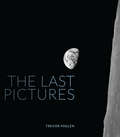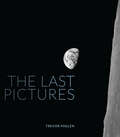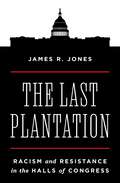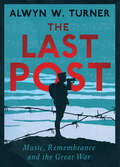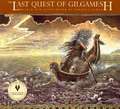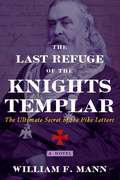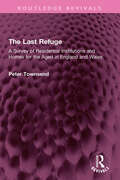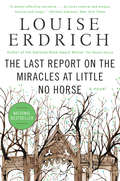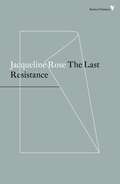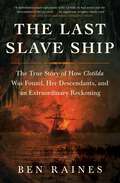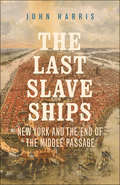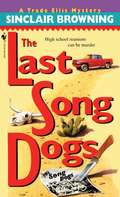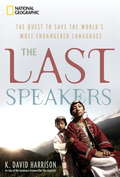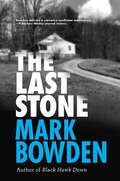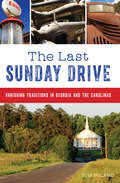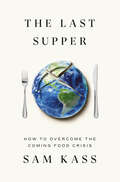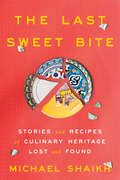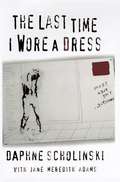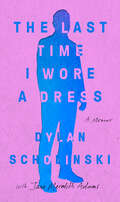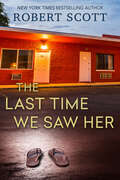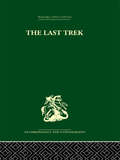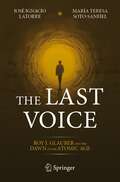- Table View
- List View
The Last Ottomans
by Kevin Featherstone Dimitris Papadimitriou Argyris MamarelisA new study of the international and local politics surrounding the Muslim minority of Western Thrace (Greece) in the 1940s, based on previously unseen archival material. Addresses the minority's complex identity, its relations with other communities in the area, the international diplomacy of WWII and strategic considerations of the Cold War.
The Last Pictures
by Trevor PaglenHuman civilizations' longest lasting artifacts are not the great Pyramids of Giza, nor the cave paintings at Lascaux, but the communications satellites that circle our planet. In a stationary orbit above the equator, the satellites that broadcast our TV signals, route our phone calls, and process our credit card transactions experience no atmospheric drag. Their inert hulls will continue to drift around Earth until the Sun expands into a red giant and engulfs them about 4.5 billion years from now. The Last Pictures, co-published by Creative Time Books, is rooted in the premise that these communications satellites will ultimately become the cultural and material ruins of the late 20th and early 21st centuries, far outlasting anything else humans have created. Inspired in part by ancient cave paintings, nuclear waste warning signs, and Carl Sagan's Golden Records of the 1970s, artist/geographer Trevor Paglen has developed a collection of one hundred images that will be etched onto an ultra-archival, golden silicon disc. The disc, commissioned by Creative Time, will then be sent into orbit onboard the Echostar XVI satellite in September 2012, as both a time capsule and a message to the future. The selection of 100 images, which are the centerpiece of the book, was influenced by four years of interviews with leading scientists, philosophers, anthropologists, and artists about the contradictions that characterize contemporary civilizations. Consequently, The Last Pictures engages some of the most profound questions of the human experience, provoking discourse about communication, deep time, and the economic, environmental, and social uncertainties that define our historical moment. Copub: Creative Time Books
The Last Pictures
by Trevor PaglenHuman civilizations' longest lasting artifacts are not the great Pyramids of Giza, nor the cave paintings at Lascaux, but the communications satellites that circle our planet. In a stationary orbit above the equator, the satellites that broadcast our TV signals, route our phone calls, and process our credit card transactions experience no atmospheric drag. Their inert hulls will continue to drift around Earth until the Sun expands into a red giant and engulfs them about 4.5 billion years from now.The Last Pictures, co-published by Creative Time Books, is rooted in the premise that these communications satellites will ultimately become the cultural and material ruins of the late 20th and early 21st centuries, far outlasting anything else humans have created. Inspired in part by ancient cave paintings, nuclear waste warning signs, and Carl Sagan's Golden Records of the 1970s, artist/geographer and MacArthur "Genius" Fellow Trevor Paglen has developed a collection of one hundred images that will be etched onto an ultra-archival, golden silicon disc. The disc, commissioned by Creative Time, will then be sent into orbit onboard the Echostar XVI satellite in September 2012, as both a time capsule and a message to the future. The selection of 100 images, which are the centerpiece of the book, was influenced by four years of interviews with leading scientists, philosophers, anthropologists, and artists about the contradictions that characterize contemporary civilizations. Consequently, The Last Pictures engages some of the most profound questions of the human experience, provoking discourse about communication, deep time, and the economic, environmental, and social uncertainties that define our historical moment.Copub: Creative Time Books
The Last Plantation: Racism and Resistance in the Halls of Congress
by James R. JonesA revealing look at the covert and institutionalized racism lurking in the congressional workplaceRacism continues to infuse Congress&’s daily practice of lawmaking and shape who obtains congressional employment. In this timely and provocative book, James Jones reveals how and why many who work in Congress call it the &“Last Plantation.&” He shows that even as the civil rights movement gained momentum in the 1960s and antidiscrimination laws were implemented across the nation, Congress remained exempt from federal workplace protections for decades. These exemptions institutionalized inequality in the congressional workplace well into the twenty-first century.Combining groundbreaking research and compelling firsthand accounts from scores of congressional staffers, Jones uncovers the hidden dynamics of power, privilege, and resistance in Congress. He reveals how failures of racial representation among congressional staffers reverberate throughout the American political system and demonstrates how the absence of diverse perspectives hampers the creation of just legislation. Centering the experiences of Black workers within this complex landscape, he provides valuable insights into the problems they face, the barriers that hinder their progress, and the ways they contest entrenched inequality.A must-read for anyone concerned about social justice and the future of our democracy, The Last Plantation exposes the mechanisms that perpetuate racial inequality in the halls of Congress and challenges us to confront and transform this unequal workplace that shapes our politics and society.
The Last Post: Music, Remembrance and the Great War
by Alwyn W. TurnerA history of the military bugle call, its use at the end of World War I on Armistice Day, and its effect in today’s culture.At eleven o’clock on the morning of the 11th November 1919 the entire British Empire came to a halt to remember the dead of the Great War. During that first two-minute silence all transport stayed still, all work ceased and millions stood motionless in the streets. The only human sound to be heard was the desolate weeping of those overcome by grief. Then the moment was brought to an end by the playing of the Last Post.A century on, that lone bugle call remains the most emotionally charged piece of music in public life. In an increasingly secular society, it is the closest thing we have to a sacred anthem. Yet along with the poppy, the Cenotaph and the tomb of the Unknown Warrior, its power is profoundly modern. It is a response to the trauma of war that could only have evolved in a democratic age.In this moving exploration of the Last Post’s history, Alwyn W. Turner considers the call’s humble origins and shows how its mournful simplicity reached beyond class, beyond religion, beyond patriotism to speak directly to peoples around the world. Along the way he contemplates the relationship between history and remembrance, and seeks out the legacy of the First World War in today’s culture.
The Last Quest of Gilgamesh
by Ludmila ZemanGilgamesh, the king of the city of Uruk, goes out in search of everlasting life after the death of his friend Enkidu.
The Last Refuge of the Knights Templar: The Ultimate Secret of the Pike Letters
by William F. MannA modern-day thriller centered on authentic historical letters encoded with Templar and Rosicrucian secrets • Includes the actual text of recently discovered correspondence between two famous 19th-century Masonic leaders, Albert Pike and Colonel J. W. B. MacLeod Moore • Follows the protagonists, Thomas and Janet, as they seek to protect the Pike letters&’ secret from the Vatican and its fanatical Jesuit hitman as well as others who desire to use the letters&’ secret for world domination • Also includes a short biography of controversial Masonic icon Albert Pike Centered on recently discovered, authenticated correspondence between two famous 19th-century Masonic leaders, Confederate General Albert Pike and British Colonel James Wilson Bury MacLeod Moore, this modern-day thriller follows Thomas, a direct descendant of Col. Moore, and Janet Rose, a direct descendant of the Merovingian Kings and House of David, as they risk their lives to protect the letters and the Templar and Rosicrucian secrets encoded within them. As Thomas and Janet discover, everyone--from the Church to the White House to Confederate sympathizers and the KKK--seeks the ancient knowledge contained within the letters, knowledge that would allow a singular entity to control the world and bring all of the great religions to their knees. Pitted against a psychotic and sexually perverted Jesuit priest, tasked by the Vatican&’s inner circle to retrieve the Pike letters, the couple is aided by two Templar guardians and a modern-day practicing alchemist, Janet&’s grandfather. As Thomas and Janet&’s love for one another grows, the couple transcends to a higher level of understanding, unaware that they are following the same ancient morals and dogma found within the 33 degrees of Scottish Rite Freemasonry, as defined by none other than Albert Pike himself. Part fact, part fiction, the novel, with its 33 initiatory chapters, provides a rare glimpse into the inner circles of modern-day Freemasonry, along with revelations of ancient alliances between Native Americans and the Templars. Set in Georgetown, in the heart of Washington, D.C., the story ends with a dramatic unveiling of the ultimate New World secret sought by so many factions: the location of the last Knights Templar refuge in the New World, where the lost treasure of the Templars, including sacred knowledge of the Holy Family--the descendants of Jesus and Mary Magdalene--remains to this day.
The Last Refuge: A Survey of Residential Institutions and Homes for the Aged in England and Wales (Routledge Revivals)
by Peter TownsendFirst published in 1964, The Last Refuge originated from the author’s visit to a Victorian workhouse which had become an Institution for old people. A visit that was to show frightful overcrowding in sparsely furnished dormitories. Day-rooms bleak and uninviting in which sat watery-eyed and feeble men, their spirit and pride drained away by the hopelessness of the surroundings. The many unexpected conditions Professor Townsend found led him to undertake this major enquiry into the question "Are communal homes for the aged necessary in our community and if so, what form should they take?" Visits were paid to a random sample of 173 residential institutions and homes, and welfare officers, matrons and elderly residents were interviewed. The general conclusion was that communal homes of the kind that existed in England and Wales did not adequately meet the physical, psychological and social needs of the old people living in them and required immediate alternative services and living arrangements. This book will be of interest to students of sociology, social care, public policy and gerontology.
The Last Report on the Miracles at Little No Horse: A Novel
by Louise ErdrichA New York Times Notable BookFor more than a half century, Father Damien Modeste has served his beloved Native American tribe, the Ojibwe, on the remote reservation of Little No Horse. Now, nearing the end of his life, Father Damien dreads the discovery of his physical identity, for he is a woman who has lived as a man. To further complicate his quiet existence, a troubled colleague comes to the reservation to investigate the life of the perplexing, possibly false saint Sister Leopolda. Father Damien alone knows the strange truth of Leopolda's piety, but these facts are bound up in his own secret. He is faced with the most difficult decision: Should he tell all and risk everything . . . or manufacture a protective history for Leopolda, though he believes her wonder-working is motivated solely by evil?In a masterwork that both deepens and enlarges the world of her previous novels set on the same reservation, Louise Erdrich captures the essence of a time and the spirit of a woman who felt compelled by her beliefs to serve her people as a priest. The Last Report on the Miracles at Little No Horse is a work of an avid heart, a writer's writer, and a storytelling genius.
The Last Resistance
by Jacqueline RoseA bravura exploration of politics and writing in dark times In The Last Resistance, Jacqueline Rose explores the power of writing to create and transform our political lives. In particular, she examines the role of literature in the Zionist imagination: here, literature is presented as a unique form of dissidence, with the power to expose the unconscious of nations, and often proposing radical alternatives to their dominant pathways and beliefs. While Israel–Palestine is the repeated focus, The Last Resistance also turns to post-apartheid South Africa, to American national fantasy post-9/11, and to key moments for the understanding of Jewish culture and memory. Rose also underscores the importance of psychoanalysis, both historically in relation to the unfolding of world events, and as a tool of political understanding. Examining topics ranging from David Grossman, through W.G. Sebald, Freud, Nadine Gordimer, the concept of evil, and suicide bombers, The Last Resistance offers a unique way of responding to the crises of the times.
The Last Slave Ship: The True Story of How Clotilda Was Found, Her Descendants, and an Extraordinary Reckoning
by Ben RainesThe incredible true story of the last ship to carry enslaved people to America, the remarkable town its survivors founded after emancipation, and the complicated legacy their descendants carry with them to this day—by the journalist who discovered the ship&’s remains.Fifty years after the Atlantic slave trade was outlawed, the Clotilda became the last ship in history to bring enslaved Africans to the United States. The ship was scuttled and burned on arrival to hide evidence of the crime, allowing the wealthy perpetrators to escape prosecution. Despite numerous efforts to find the sunken wreck, Clotilda remained hidden for the next 160 years. But in 2019, journalist Ben Raines made international news when he successfully concluded his obsessive quest through the swamps of Alabama to uncover one of our nation&’s most important historical artifacts. Traveling from Alabama to the ancient African kingdom of Dahomey in modern-day Benin, Raines recounts the ship&’s perilous journey, the story of its rediscovery, and its complex legacy. Against all odds, Africatown, the Alabama community founded by the captives of the Clotilda, prospered in the Jim Crow South. Zora Neale Hurston visited in 1927 to interview Cudjo Lewis, telling the story of his enslavement in the New York Times bestseller Barracoon. And yet the haunting memory of bondage has been passed on through generations. Clotilda is a ghost haunting three communities—the descendants of those transported into slavery, the descendants of their fellow Africans who sold them, and the descendants of their American enslavers. This connection binds these groups together to this day. At the turn of the century, descendants of the captain who financed the Clotilda&’s journey lived nearby—where, as significant players in the local real estate market, they disenfranchised and impoverished residents of Africatown. From these parallel stories emerges a profound depiction of America as it struggles to grapple with the traumatic past of slavery and the ways in which racial oppression continue to this day. And yet, at its heart, The Last Slave Ship remains optimistic – an epic tale of one community&’s triumphs over great adversity and a celebration of the power of human curiosity to uncover the truth about our past and heal its wounds.
The Last Slave Ships: New York and the End of the Middle Passage
by John HarrisA stunning behind-the-curtain look into the last years of the illegal transatlantic slave trade in the United States"Engrossing. . . . Astonishingly well-documented. . . . A signal contribution to U.S. antebellum historiography. Highly recommended for U.S. Middle Period, African American, and Civil War historians, and for all general readers."--Library Journal, Starred Review Long after the transatlantic slave trade was officially outlawed in the early nineteenth century by every major slave trading nation, merchants based in the United States were still sending hundreds of illegal slave ships from American ports to the African coast. The key instigators were slave traders who moved to New York City after the shuttering of the massive illegal slave trade to Brazil in 1850. These traffickers were determined to make Lower Manhattan a key hub in the illegal slave trade to Cuba. In conjunction with allies in Africa and Cuba, they ensnared around two hundred thousand African men, women, and children during the 1850s and 1860s. John Harris explores how the U.S. government went from ignoring, and even abetting, this illegal trade to helping to shut it down completely in 1867.
The Last Song Dogs (Trade Ellis Mystery #1)
by Sinclair Browning(Back Cover)DYING TO ATTEND Trade Ellis is part Apache, part cowgirl, the owner of an Arizona ranch, and a licensed private eye. Her cases are mostly routine...until someone starts thinning the ranks of the cheerleading squad from her old high school class in Tucson. Clearly the killer has lost his or her school spirit. With the twenty-five-year class reunion just around the corner, the remaining cheerleaders aren't making party plans. Trade has enough suspects to fill a yearbook. The fading beauty, the rich gal who sleeps around, the addict and hooker who did time on a murder rap. Or maybe it's the fading beauty's loutish husband, who slept with half the class...and still does. Or the one-time nerd turned wealthy hunk, who has a macabre taste in objets d'art. Whoever it is, Trade had better find out fast, before the killer decides she should join the cheerleading squad...in the morgue.
The Last Speakers
by K. David HarrisonPart travelogue and part scientist's notebook, The Last Speakers is the poignant chronicle of author K. David Harrison's expeditions around the world to meet with last speakers of vanishing languages. The speakers' eloquent reflections and candid photographs reveal little-known lifeways as well as revitalization efforts to teach disappearing languages to younger generations. Thought-provoking and engaging, this unique book illuminates the global language-extinction crisis through photos, graphics, interviews, traditional wisdom never before translated into English, and first-person essays that thrillingly convey the adventure of science and exploration.
The Last Speakers: The Quest to Save the World's Most Endangered Languages
by K. David HarrisonPart travelogue and part scientist's notebook, The Last Speakers is the poignant chronicle of author K. David Harrison's expeditions around the world to meet with last speakers of vanishing languages. The speakers' eloquent reflections and candid photographs reveal little-known lifeways as well as revitalization efforts to teach disappearing languages to younger generations. Thought-provoking and engaging, this unique book illuminates the global language extinction crisis through photos, graphics, interviews, traditional wisdom never before translated into English, and first-person essays that thrillingly convey the adventure of science and exploration.
The Last Stone: A Masterpiece Of Criminal Interrogation
by Mark BowdenThe true story of a cold case, a compulsive liar, and five determined detectives, from the #1 New York Times–bestselling author and &“master journalist&” (The Wall Street Journal). On March 29, 1975, sisters Katherine and Sheila Lyons, ages ten and twelve, vanished from a shopping mall in suburban Washington, DC As shock spread, then grief, a massive police effort found nothing. The investigation was shelved, and the mystery endured. Then, in 2013, a cold case squad detective found something he and a generation of detectives had missed. It pointed them toward a man named Lloyd Welch, then serving time for child molestation in Delaware. The acclaimed author of Black Hawk Down and Hue 1968 had been a cub reporter for a Baltimore newspaper at the time of the original disappearance, and covered the frantic first weeks of the story. In The Last Stone, he returns to write its ending. Over months of intense questioning and extensive investigation of Welch&’s sprawling, sinister Appalachian clan, five skilled detectives learned to sift truth from determined lies. How do you get a compulsive liar with every reason in the world to lie to tell the truth? The Last Stone recounts a masterpiece of criminal interrogation, and delivers a chilling and unprecedented look inside a disturbing criminal mind. &“One of our best writers of muscular nonfiction.&” —The Denver Post &“Deeply unsettling . . . Bowden displays his tenacity as a reporter in his meticulous documentation of the case. But in the story of an unimaginably horrific crime, it&’s the detectives&’ unwavering determination to bring Welch to justice that offers a glimmer of hope on a long, dark journey.&” —Time
The Last Sunday Drive: Vanishing Traditions in Georgia and the Carolinas
by Tom PolandThe Sunday drive. Mom, dad and the kids would head out to see the countryside. An ice cream treat usually waited at day's end. Back in the Burma-Shave days, mom-and-pop drive-ins and gas station biscuits fed folks. Cheap gas filled cars, and people made Sunday drives through a land where See Rock City barns, sawdust piles and trains and junkyards gave them plenty to see. Men in seersucker suits ran old stores with oscillating fans, and if the kids ate too much penny candy, grandma had a home remedy for them. It was a time for dinner on church grounds, yard art and old-fashioned petunias. Join author Tom Poland as he revisits disappearing traditions.
The Last Supper: How to Overcome the Coming Food Crisis
by Sam KassA former senior food policy advisor to President Obama breaks down how changing the way we eat can help fix the climate crisis, from rethinking daily habits to investing in new technology.&“Smart, timely, and full of purpose.&”—Michelle Obama&“A wake‑up call for the future of our planet.&”—Chef José Andrés&“An impressively compelling manifesto for food system transformation.&”—Marion NestleAs a chef in high-end restaurants, and later, in the home of then Senator Barack and Michelle Obama, Sam Kass read a lot about how eating organic and buying local was the key to remaking a food system otherwise built on climate-change-causing petroleum. But when he followed the Obamas into the White House, he realized something: While it&’s easy to identify the problems in our spoiled food system, fixing it is not as simple as getting your eggs from the farmers&’ market. Now investing in startups trying to solve the environmental and human challenges of climate change in food and agriculture.In The Last Supper, Kass shares everything he&’s learned, simplifying it all down to what he calls &“The Core Principle&”: Maximize nutrient production while minimizing environmental damage. He lays out an accessible, action-based plan to save the environment, and in turn, ourselves, based on four pillars of change:• Culture: shifting the way we think about and approach the environment as individuals is the foundation of broader change• Policy and legislation: the limited but important role of policy and how change is made on a governmental level and what we can do about it• Business: How to change the businesses that provide the food we eat as the only path to change our food system• Technology: a deep dive into the future with the new and innovative technologies researchers are using to save the environment, from CRISPR and Loam Bio to the magic of mycelium and the secret weapon that is regenerative farmingThrough anecdotes, interviews, and an astounding amount of research, The Last Supper gives us the tools we need to make a difference.
The Last Sweet Bite: Stories and Recipes of Culinary Heritage Lost and Found
by Michael ShaikhA powerful and heartwarming exploration of cuisine in conflict zones, highlighting the courageous persistence of people struggling to protect their food culture in the face of war, genocide, and violence.&“The Last Sweet Bite tells the powerful and personal stories of the heroic home cooks fighting to keep their food—and their identity—alive.&”—José Andrés, founder of World Central KitchenWar changes every part of human culture: art, education, music, politics. Why should food be any different? For nearly twenty years, Michael Shaikh&’s job was investigating human rights abuses in conflict zones. Early on, he noticed how war not only changed the lives of victims and their societies, it also unexpectedly changed the way they ate, forcing people to alter their recipes or even stop cooking altogether, threatening the very survival of ancient dishes.A groundbreaking combination of travel writing, memoir, and cookbook, The Last Sweet Bite uncovers how humanity&’s appetite for violence shapes what&’s on our plate. Animated by touching personal interviews, original reporting, and extraordinary recipes from modern-day conflict zones across the globe, Shaikh reveals the stories of how genocide, occupation, and civil war can disappear treasured recipes, but also introduces us to the extraordinary yet overlooked home cooks and human rights activists trying to save them. From a sprawling refugee camp in Bangladesh and a brutal civil war in Sri Lanka to the drug wars in the Andes and the enduring effects of America&’s westward expansion, Shaikh highlights resilient diasporic communities refusing to let their culinary heritage become another casualty of war.Much of what we eat today or buy in a market has been shaped by violence; in some form, someone&’s history and politics is on the dinner table. The Last Sweet Bite aims to tell us how it got there. Weaving together histories of food, migration, human rights, and recipes, Shaikh shows us how reclaiming lost cuisines is not just a form of resistance and hope but also how cooking can be a strategy for survival during trying times.
The Last Tales of Uncle Remus
by Julius LesterWith his boisterous friends and rowdy enemies, Brer Rabbit is on the road to adventure. He gets a job and figures out how to get paid--twice a day!
The Last Time I Wore a Dress
by Daphne ScholinskiAt the age of fifteen, Daphne Scholinski was put in a mental hospital for what her psychiatrist called? failure to identity as a sexual female.' The hospital gave her a diagnosis that was brand-new to the medical books: Gender Identity Disorder. The years that should have been Daphne's typical high school experience instead consisted of periods of seclusion and physical restraint, frequent does of sedatives, and the close company of people who were truly crazy. It’s hard to believe that doctors, circa 1981, described Daphne's treatment goals as becoming more obsessive about boys, learning about makeup, dressing more like a girl, curling and styling hair, and spending quality time learning about girl things with peers. Even now, after a decade and a half of our culture's coming to grips with homosexuality, approximately fifty thousand teenagers are institutionalized in the U.S. each year for being too sissy or too much of a tomboy. Though the facts are truly frightening, Jane Meredith Adams has captured Daphne's fresh, funny, triumphant voice so vividly that The Last Time I Wore a Dress is impossible to put down. The result is a book is reminiscent of The Catcher in the Rye and One Flew Over the Cuckoo's Nest as well as an expose of a shameful medical sham that has destroyed countless childhoods.
The Last Time I Wore a Dress
by Dylan ScholinskiUPDATED WITH A NEW EPILOGUE At fifteen years old, Daphne Scholinski was committed to a mental institution and awarded the dubious diagnosis of Gender Identity Disorder. For three years and more than a million dollars of insurance, the problem was &“treated&”—with makeup lessons and instructions in how to walk like a girl. With a new epilogue by Scholinski, whose name is now Dylan and who identifies as nonbinary, this revised paperback edition of The Last Time I Wore a Dress looks back at those experiences and their life since. It chronicles the journey of coming into oneself and gaining a nuanced, freeing understanding of being born transgender. This memoir tells Dylan Scholinski&’s remarkable story in an honest, unforgettable voice that&’s both heartbreaking and hopeful.
The Last Time We Saw Her
by Robert ScottDeeply Loved, Sadly MissedBlonde, 19-year-old Brooke Wilberger was raised in a close-knit religious family. On a summer morning in Oregon, while cleaning lampposts at an apartment complex managed by her sister, Brooke vanished. One moment she was there, the next moment all that was left were her flip flops and the echo of her scream. Her family suffered five long years to learn that their worst fears were true. Brooke's life had been snatched brutally away by Joel Courtney, a serial predator who said he hadn't meant to kill her. But the stories of other women made it clear that Courtney was pure evil. . .Includes dramatic photos.Praise for Robert Scott and Shattered Innocence"Compelling and shocking. . .a ground-breaking book." --Robert K. Tanenbaum"Fascinating and fresh. . .a fast-paced, informative read." --Sue Russell
The Last Trek: A Study of the Boer People and the Afrikaner Nation
by Sheila PattersonThis book evaluates the historical factors that produced the Boer people, and the political, religious and economic forces that maintain modern Afrikaner Nationalism. This last trek brings the Afrikaner back into multi-racial integrating industrial society. Originally published in 1957.
The Last Voice: Roy J. Glauber and the Dawn of the Atomic Age
by José Ignacio Latorre María Teresa Soto-SanfielMost human beings don’t manage to achieve fame. Roy J. Glauber did so for two different reasons. Glauber was not only a Nobel-Prize winning physicist, but also one of the last surviving scientists who worked in Los Alamos in the Theoretical Division of the Manhattan Project. He was a witness to all the events and knew all the scientists associated with the creation and launch of the first atomic bombs. This book is the product of a series of long interviews held with Roy over three years: in Benasque (Spain) in 2011, and later in Singapore and Cambridge (USA). Its pages give a first-hand account of a true protagonist, one who is independent, lucid, sagacious and committed to the truth. The authors have respectfully preserved his spirit: his voice is the one that matters. The authors asked the questions and they relay his answers. Their comments are confined to the footnotes and to brief explanatory paragraphs, added simply to provide certain relevant details. The importance of the events that Glauber describes here is indisputable, as therefore is the book itself. The events narrated in its pages will remain part of world history, perhaps for centuries or even millennia. We live today in the shadow of the decisions made at that time.

